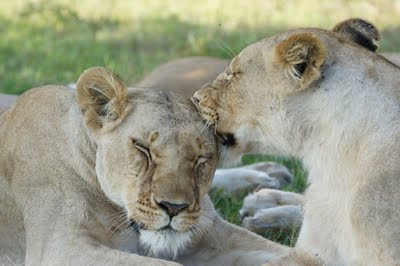The old adage about keeping your camera close while on safari in Africa (or anywhere else for that matter), came true the other day while on a transfer from the Samburu Intrepids camp to the airstrip in Buffalo Springs. I always like carrying my camera in a separate bag (from other baggage) so I can reach for it quickly if need be.
Well, this was a normal unexciting trip to the airstrip from Samburu Intrepids - a 15 minute drive - when coming round a bend to cross a lugga (dry river bed), we came across what at first sight we though was a did dik running for his dear life from a pack of wild dogs (Cape hunting dogs). It was in fact, a baby gerenuk. The signs were ominous immediately - he stood no chance. In a desperate dash, he tried to get away from the leader of the chasing pack by running under our jeep, and sadly hit his head in the under carriage. By the time the driver had stopped, just some five meters away, he lay kicking on the ground with some blood oozing from his head - he had either broken his neck or something vital.
Mercifully, he wasn't in pain for long - in a flash, the leader of the hunting dogs, who had himself avoided hitting the vehicle by a whisker was on him. The rest of the pack which had spanned out in the bush landed in a matter of seconds. Just as i was reaching to grab my camera - which was in a bag on my lap - it was over. These were the sequence of shots taken in less than a minute, and what transpired.
 |
| The pack tears the baby gerenuk mercilessly |
 |
| And splits him in two |
 |
| They fight for the spoils |
 |
| It's all done |
 |
| Someone got a good morsel.. |
NB This pack of wild dogs has become common in Samburu, with our blog featuring them severally. They seem to have adopted a new survival tactic; taking up to the hills once they have fed where they are away from bigger animals or humans, and their numbers seem to be increasing.
They were once hunted viciously (and mainly) due to human's distate to their hunting methods and lack of specific prey - they don't normally strangle a kill like other bigger predators but instead tear it apart while still alive, like what is shown in these pictures, which humans find cruel. They have also hunted and fed on livestock, bringing them in conflict with pastoralists with whom they share common areas. These pastoralists used to poison or hunt and kill, making them an endangered species.
Heritage Hotels (Kenya) manages one luxury camp in the Samburu National Reserve - Samburu Intrepids Camp - on the shaded banks of the *Uaso Nyiro. All the tents are spread along the banks with a private shaded verandah with a nice view of the flowing river.
* Also known as Ewaso Nyiro, Samburu for 'the brown river'.
Report and pictures by Ndeithi Kariuki.©Heritage Hotels Ltd, Kenya.http://www.heritage-eastafrica.com/















































